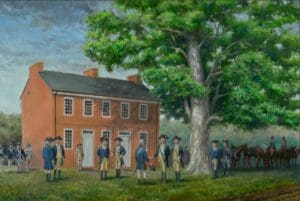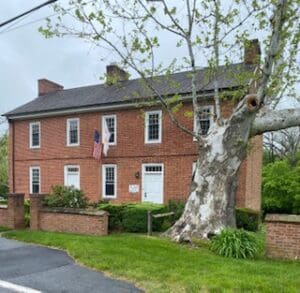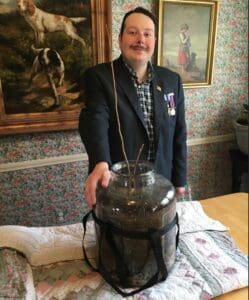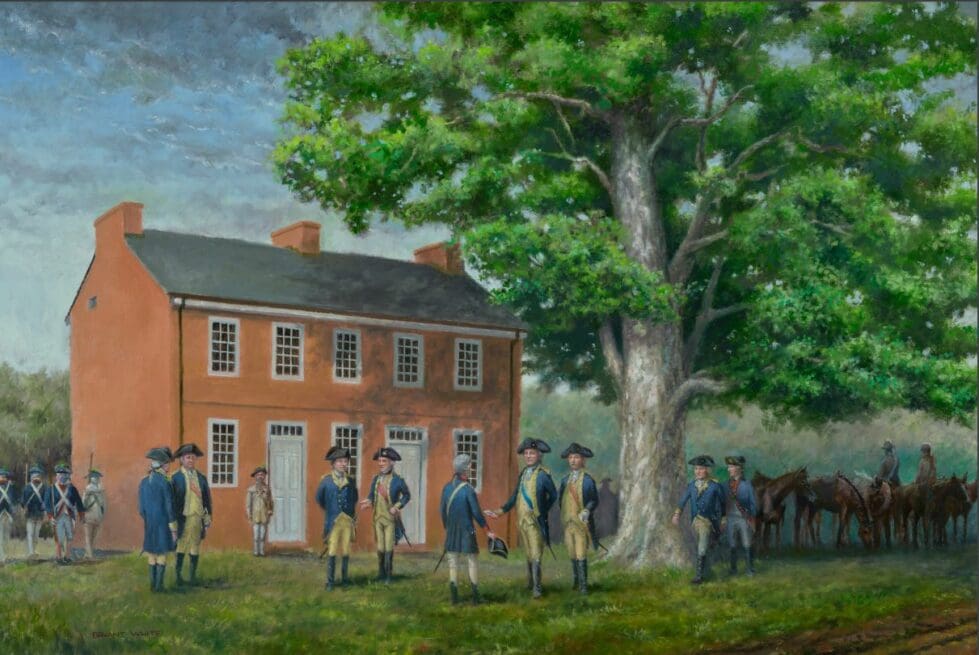
The Hale Byrnes House on Dec. 3 will unveil a new painting featuring a now-dying American sycamore under which George Washington held a meeting before the Battle of the Brandywine.
The Hale Brynes House this weekend will unveil a painting featuring an American sycamore tree under which George Washington once held a council of war with the Marquis de Lafayette.
The Newark nonprofit commissioned the painting because the 300-plus-year-old witness tree — called that because it was alive during a historical moment — may soon die or be removed.
Leaning precipitously toward the 270-year-old house, the sycamore is battling multiple tree diseases and has a hollow in its trunk large enough for adults to stand in.
“It was full grown when Washington was here on Sept. 6, 1777,” said Kim Burdick, a historian and resident manager of the house.
Since then, the once-flat lot has eroded and tree branches have been lopped off by the state and utility companies because they’ve stretched over the road.
Burdick said she’s not sure how tall the tree is, but it is taller than power lines, she said.
More than two men would be needed to reach around the trunk, she said, and several board members are worried the tree might fall on the house.
As the group considers what to do — and for the moment, the state arborist’s advice is to not worry as long as the witness tree fully leafs out in the spring — one volunteer has grown seedlings from the tree.
Only a handful of Josh Loper’s nearly three dozen attempts survived.
One already is in ground in Pittsgrove, New Jersey, where it has grown taller than 5 feet. That site was chosen because its soil is similar to the soil at the Hale Brynes house, where the tree flourished for centuries.
Both the town of Dover and Historic New Castle are considering a place to plant one of the seedlings, Loper said.

The American sycamore that once sheltered George Washington and his generals is at the end of its life at the Hale Byrnes House.
Hale Brynes history
A few days before the Sept. 11, 1777, Battle of the Brandywine, Washington met beneath the tree’s limbs with Lafayette, “Mad” Anthony Wayne, “Fighting Quaker” Nathanael Greene and Henry Knox, a bookseller turned artillery whiz.
He and the generals were laying plans to stop the British from taking Philadelphia.
The painting, “Prelude to Brandywine” by Virginia artist Bryant White, was commissioned by the American Revolution Round Table of Delaware. The round table is sponsored by the Hale Byrnes organization.
The unveiling will be at 3 p.m. Saturday, Dec. 3, at the house at 606 Stanton-Christiana Road, Newark, Delaware, just past the intersections of Route 7 North and Route 4.
White, who specializes in Revolutionary War-era art, will talk about his painting at 7:30 p.m. at the house.
The round table found White through Lynn King, a member of the historical re-enactment group First Delaware Regiment. King had met White and his wife, Pamela, at various re-enactments and worked through the Hale Byrnes board to hire him.
Burdick particularly likes the folk art feeling that comes through in the painting.
King points out that White researched what Washington would have been wearing and included a blue sash the Founding Father would have worn then, but later stopped wearing because he felt it was a British sign of aristocracy he didn’t think was appropriate for the colonies.
White also included a subtle peek at one of the two horses that Washington rode during the war, a whitish-gray half-Arabian named Blueskin.
When Bryant finished with the painting, he met King at a re-enactment in another state and she brought back the painting. Burdick said it’s about the size of a standard poster.
“Prelude to Brandywine” will hang on a wall in the front room of the house, where visitors enter.
“So you can see the tree by looking out the front door and see the painting right ahead of you inside the room,” Burdick said.

Josh Loper shows off one of the cuttings from the Hale Byrnes House’s witness tree.
Creating seedlings
Loper, whose family came to the Americas in 1615, has been interested in history, particularly Colonial history, since he was a child.
When Burdick asked Loper to become a docent at the house, he was shocked at the condition of the witness tree. He asked Burdick if he could try making seedlings and she told him he could do whatever he could.
That launched Loper on a journey through plant science, starting with monumentaltrees.com. He discovered the American sycamores either grow tall with thinner trunks or, as the witness tree did, shorter with broad trunks.
He was told that even if he used seedlings or seeds from the tree to grow more, those new trees wouldn’t be a clone of the tree. They would be a new generation.
Eventually, Loper decided to take a few cuttings from the tree — and ended up with dozens.
He planted the cuttings in batches following various methods recommended, including brushing cuttings with rooting hormone and putting them in special mediums.
The only batch that survived were the ones he didn’t use the rooting hormone on and just placed in muddy water.
Loper still has a few cuttings that are unspoken for, but he also has criteria about where the tree can be placed.
The next generation will need specific soil and environmental factors, and should be a fairly safe location where it’s protected from vandals, Loper said.
He would like them planted in significant locations and not — as someone asked — in front of a fast food restaurant.
One seedling is being saved to replace the witness tree when it dies or has to be removed, he said.
Loper now is interested in propagating other significant trees.
“Believe it or not, I have found out there are trees just as old that were either at important battles or even at things that just might seem mundane, that like a minor skirmish,” he said. “But they’re still there nonetheless and still alive.”
Using the wood
Burdick and those working with her hope the unveiling of the painting and the story of the witness tree will bring more attention to the house and to the Revolutionary War.
Places like the Hale Byrnes House are instrumental in understanding the war, said Lynn King.
“That’s where you learn your history,” she said, “coming to these places and listening to people who have researched them, because they are not teaching it in school.”
NEW DINING SCENE: Here’s a sneak peek at The Chancery Market Food Hall & Bar
NEW POLITICAL VIEW: The Delaware GOP needs to change to be effective, leaders say
When — and nobody says “if” — the tree falls or is removed, the round table has a committee considering what to do with the wood.
Suzanne Savery, director of the Delaware Division of Historical and Cultural Affairs, says that the state archives has a slice of a Massachusetts tree under which Washington once stood.
When that tree died in the 1920s, an organization there sent every state a slice of the tree, she said.
Hale Byrnes will not be following that model, Burdick said.
Jerry Bilton, who once owned a downtown Wilmington art gallery, is heading a committee to decide what to do with any usable wood.
“They were thinking about things like picture frames and mallets and stuff like that,” Burdick said.
Barbara Seningen of the Delaware Daughters of the American Revolution already has sent $50 in the hopes of getting a gavel to use in meetings, Burdick said.
The committee is talking to woodworkers about what could be created.
While sycamores are hardy and long-lasting, their wood is not as strong as oak, Burdick said, and that will play a roll in what can be done.

Betsy Price is a Wilmington freelance writer who has 40 years of experience, including 15 at The News Journal in Delaware.
Share this Post




